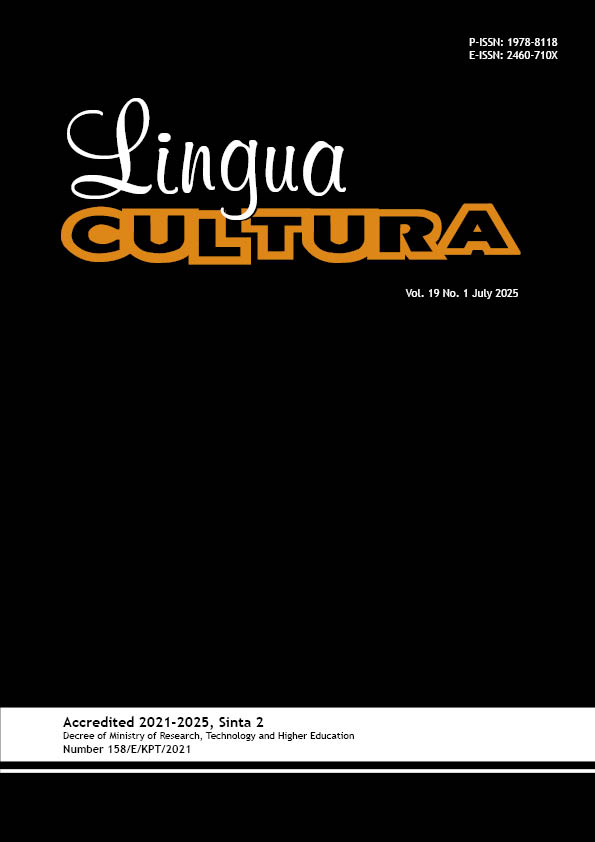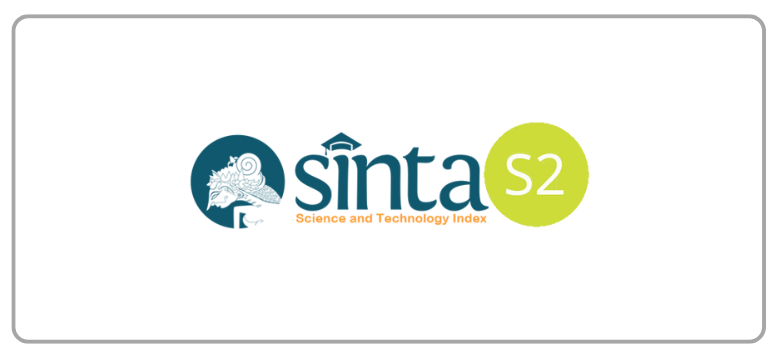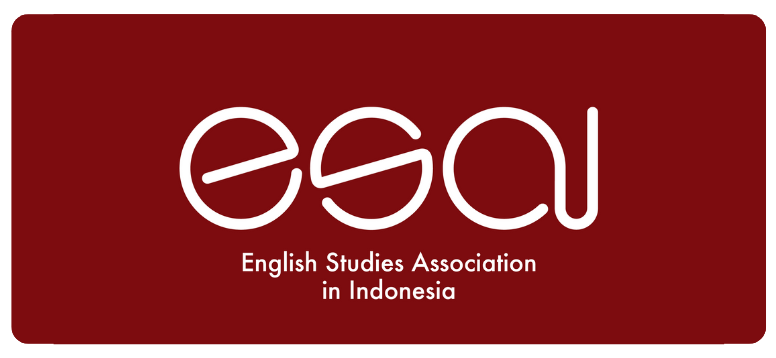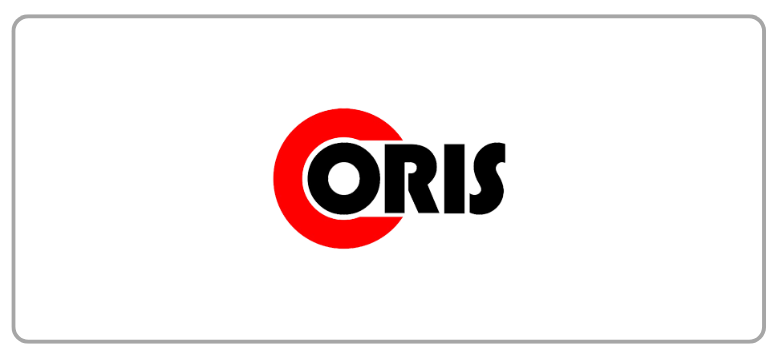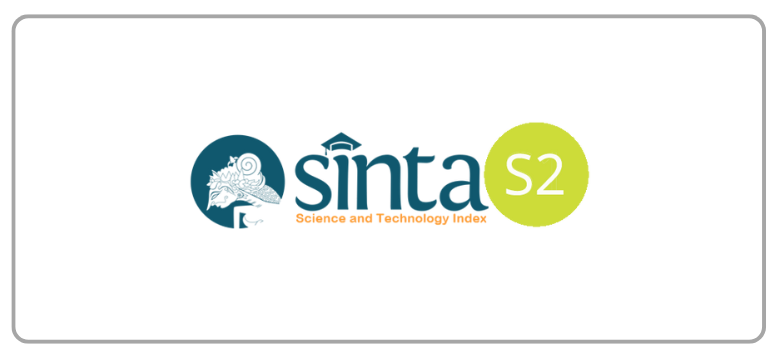The Struggle for Survival in a Post-Atomic Bombing City in John Hersey’s Hiroshima
DOI:
https://doi.org/10.21512/lc.v19i1.12840Keywords:
Formalist approach, Hiroshima, metropolitan environment, post-disaster environment, urban life settingsAbstract
Written in the form of literary journalism, Hershey’s Hiroshima offers a vivid portrayal of urban life in Hiroshima, providing significant insights into the structure and themes of the book. This literary analysis examines how the novel portrays metropolitan environments and their significance in conveying the concepts of urban settings. Through the application of a sociological approach to literature, the research investigates the fundamental elements of the fiction, particularly its spatial settings, such as streets and buildings, to understand how these environments reflect and shape the social context, mood, and meaning of the narrative. The research findings indicate that the novel portrays urban life through its depiction of Hiroshima’s urban landscape, where temporal and social conditions shape the novel’s central themes. Hersey’s novel Hiroshima exposes the important themes of physical destruction and the resilience of the victims of catastrophe. These main findings underscore the significant role of urban settings in literary journalism, suggesting how Hersey’s depiction of Hiroshima's streets and structures enhances the reader's understanding of the catastrophic impact of the Allies’ bombing on Japanese urban life.
References
Aare, C. (2023). The case of literary journalism: Rethinking fictionality, narrativity, and imagination. Style, 57(4), 440-458. Scholarly Publishing Collective. https://doi.org/10.5325/style.57.4.0440
Angenot, M. (1989). 1889: Un état du discours social. Longueuil, Québec: Le Préambule.
Balaa, L. (2021). Who are you? Journal of International Women’s Studies, 22(5), 478-479.
Borer, M. I. (2006). The location of culture: The urban culturalist perspective. City & Community, 5(2), 173-197. https://doi.org/10.1111/j.1540-6040.2006.00168.x
Boyd, G. A., & Linehan, D. (2018). Becoming atomic: The bunker, modernity, and the city. Architectural Research Quarterly, 22(3), 241-255. Cambridge Core. https://doi.org/10.1017/s1359135518000581
Cavagnini, G. (2022). La scienza in giallo Sciascia, i fisici italiani e il caso Majorana nelle carte di Gian Carlo Wick (1975-1989). Contemporanea, 25(1), 55-76. https://doi.org/10.1409/101703
Christie, S. (2010). The sounds an atomic bomb makes: John Hersey’s Hiroshima and the birth of ‘Asian’ modernity. Comparative Literature: East & West, 13(1), 9-20. https://doi.org/10.1080/25723618.2010.12015565
Ferdinal, F. (2013). Censorship, resistance and transformation in modern Indonesian literature. Mediterranean Journal of Social Sciences, 4(1), 269.
Ferdinal, F. (2015). Responses to human rights issues in Indonesian new order fiction. Research Journal of Social Sciences, 8(12), 54-58.
Ferdinal, F., Oktavianus, O., & Djusmalinar. (2024). Scrutinizing the representations of flood disaster imagery in Emile Zola’s work. The 4th International Conference on Disaster Management (The 4th ICDM 2024), 604. https://doi.org/10.1051/e3sconf/202560402003
Ferdinal, F., Sudarmoko, S., Dewi, C., & Oktavianus, O. (2025). Dismembering the issues of capitalism, human rights, and mental health of Irish people in the novel Normal People by Sally Rooney. OKARA: Jurnal Bahasa Dan Sastra, 18(2), 266-284. https://doi.org/10.19105/ojbs.v18i2.15659
Fields, A. (2022). Visualizing faith and futility in the nuclear apocalypse. Religions, 13(2), 142. https://doi.org/10.3390/rel13020142
Gerstle, D. (2012). John Hersey and Hiroshima. Dissent, 59(2), 90-94.
Giorgi, E., Bugatti, A., & Bosio, A. (2020). Social and spatial experiences in the cities of tomorrow. Societies, 10(1), 9. https://doi.org/10.3390/soc10010009
Hawkins, T., & Kim, A. (2021). Legitimate authority. In T. Hawkins & A. Kim (Eds.), Just War Theory and Literary Studies: An Invitation to Dialogue (pp. 33-54). Springer International Publishing. https://doi.org/10.1007/978-3-030-79863-5_3
Hébert, L. (2022). Introduction to literary analysis: A complete methodology. Routledge.
Hecht, D. K. (2022). Embracing mystery: Radiation risks and popular science writing in the early cold war. In J. Hamblin & L. M. Richards (Eds.), Connecting to the Living History of Radiation Exposure (pp. 127-141). Springer Nature Switzerland; Springer Nature. https://doi.org/10.1007/978-3-031-18758-2_7
Hersey, J. (1946). Hiroshima. Vintage.
Howard, J. (2017). Form and history in American literary naturalism. The University of North Carolina Press.
Hurley, B. (2024). Reading Hiroshima in the age of Vietnam: John Hersey at the White House festival of the arts. The Asia-Pacific Journal: Japan Focus, 22(3), 1-15. https://doi.org/10.1017/S1557466024029036
Kırmızı, M. (2019). Japanese gentrification from a local community perspective. City & Community, 18(2), 618-637. Sage Journals. https://doi.org/10.1111/cico.12391
Latini, M. (2015). The vision of the end: Anders on the TV series holocaust. Cinéma & Cie: International Film Studies Journal: XV, 25, 2015, XV(25), 115-124.
Li, M., & Neill, D. R. (2018). Activities and roles played by architects in the reconstruction of Hiroshima after its atomic bombing. International Review for Spatial Planning and Sustainable Development, 6(1), 53-78. https://doi.org/10.14246/irspsd.6A.1_53
Lőwensteinová, M. (2024). Korean war narratives in 1950s Czechoslovakia. Asian & African Studies (13351257), 33(1). https://doi.org/10.31577/aassav.2024.33.1.02
Matray, J. I. (2022). US Entry into the Korean War: Origins, impact, and lessons. Journal for Peace and Nuclear Disarmament, 5(sup1), 167-184. Taylor & Francis Online. https://doi.org/10.1080/25751654.2022.2053407
McKeown, P. D. (2004). The image of the city and urban literature: A comparative study between James Joyce’s Dubliners, Hanif Kureishi’s The Buddha of Suburbia, and Irvine Welsh’s Glue (Doctoral dissertation). https://macsphere.mcmaster.ca/bitstream/11375/12122/1/fulltext.pdf
Miller, A., & Atherton, C. (2020). ‘The Chernobyl hibakusha’: Dark poetry, the ineffable and abject realities. TEXT: Journal of Writing and Writing Courses, 25(1), 1-19.
Molella, A., & Kargon, R. (2023). Atomville: Architects, planners, and how to survive the bomb. Technology and Culture, 64(3), 823-844. Project Muse. https://doi.org/10.1353/tech.2023.a903974
Pickett, G. L. (2024). “So beautiful that mortal… eyes can’t take it”: How postmodernism shows us the function of the beautiful in the landscape of the traumatic. Humanities, 13(5), 132. https://doi.org/10.3390/h13050132
Rey-Pérez, J., & Roders, A. P. (2020). Historic urban landscape: A systematic review, eight years after the adoption of the HUL approach. Journal of Cultural Heritage Management and Sustainable Development, 10(3), 233-258. Emerald Insight. https://doi.org/10.1108/JCHMSD-05-2018-0036
Rosen, T. L. (2023). The Atomic City: A Firsthand Account by a Son of Los Alamos. Eakin Press.
Rothman, S. (1987, January 8). Hiroshima. The Publication of “Hiroshima” in The New Yorker. https://www.herseyhiroshima.com/
Scheibach, M. (2021). Faith, fallout, and the future: Post-apocalyptic science fiction in the early postwar era. Religions, 12(7), 520. MDPI. https://doi.org/10.3390/rel12070520
Sharp, P. B. (2000). From yellow peril to Japanese wasteland: John Hersey’s" Hiroshima". Twentieth Century Literature, 46(4), 434-452.
Shimizutani, S., & Yamada, H. (2021). Long-term consequences of the atomic bombing in Hiroshima. Journal of the Japanese and International Economies, 59, 101119. Science Direct. https://doi.org/10.1016/j.jjie.2020.101119
Swanberg, S. E. (2021). Under the influence: The impact of Johannes A. Siemes, SJ’s eyewitness report on John Hersey’s" Hiroshima". Literary Journalism Studies, 13(1 and 2), 131-161.
Taskiran, M. N., & Kara, M. (2021). The true-based narrative: An analysis on John Hersey’s Hiroshima. In Handbook of Research on Narrative Interactions (pp. 29-42). IGI Global. https://www.igi-global.com/chapter/the-true-based-narrative/270559
Toyosaki, S. (2020). Performative remembering of Hiroshima’s and my father’s silence. Journal of Intercultural Communication Research, 49(5), 458-471. Taylor & Francis Online. https://doi.org/10.1080/17475759.2020.1811752
Walsh, B. P. (2019). “Japanese foreign ministry’s document destruction order of 7 August 1945.” Journal of American-East Asian Relations, 26(1), 85-94. Brill. https://doi.org/10.1163/18765610-02601005
Wolfel, R. L., Richmond, A., & Grazaitis, P. (2017). Seeing the forest through the trees: Sociocultural factors of dense urban spaces. Urban Science, 1(4), 40. https://doi.org/10.3390/urbansci1040040
Zhu, Z., Zhou, Y., Seto, K. C., Stokes, E. C., Deng, C., Pickett, S. T. A., & Taubenböck, H. (2019). Understanding an urbanizing planet: Strategic directions for remote sensing. Remote Sensing of Environment, 228, 164-182. Science Direct. https://doi.org/10.1016/j.rse.2019.04.020
Downloads
Published
How to Cite
Issue
Section
License
Copyright (c) 2025 Ferdinal Ferdinal, Muhammad Iqbal, Chintya Dewi

This work is licensed under a Creative Commons Attribution-ShareAlike 4.0 International License.
Authors who publish with this journal agree to the following terms:
a. Authors retain copyright and grant the journal right of first publication with the work simultaneously licensed under a Creative Commons Attribution License - Share Alike that allows others to share the work with an acknowledgment of the work's authorship and initial publication in this journal.
b. Authors are able to enter into separate, additional contractual arrangements for the non-exclusive distribution of the journal's published version of the work (e.g., post it to an institutional repository or publish it in a book), with an acknowledgment of its initial publication in this journal.
c. Authors are permitted and encouraged to post their work online (e.g., in institutional repositories or on their website) prior to and during the submission process, as it can lead to productive exchanges, as well as earlier and greater citation of published work.
USER RIGHTS
All articles published Open Access will be immediately and permanently free for everyone to read and download. We are continuously working with our author communities to select the best choice of license options, currently being defined for this journal as follows: Creative Commons Attribution-Share Alike (CC BY-SA)
